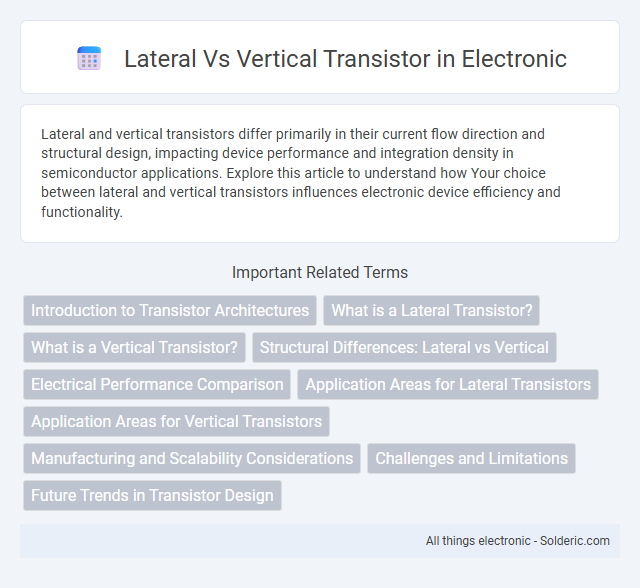Lateral and vertical transistors differ primarily in their current flow direction and structural design, impacting device performance and integration density in semiconductor applications. Explore this article to understand how Your choice between lateral and vertical transistors influences electronic device efficiency and functionality.
Comparison Table
| Feature | Lateral Transistor | Vertical Transistor |
|---|---|---|
| Structure Orientation | Horizontal channel flow | Vertical channel flow |
| Channel Length Control | Limited by lithography | Enhanced control via depth |
| Switching Speed | Moderate speed | Higher speed due to short channels |
| Integration Density | Lower density | Higher density from vertical stacking |
| Manufacturing Complexity | Relatively simpler | More complex fabrication |
| Use Cases | Standard ICs, analog circuits | Advanced ICs, 3D memory, power devices |
| Heat Dissipation | Moderate | Improved due to vertical heat flow |
Introduction to Transistor Architectures
Lateral transistors feature device channels oriented parallel to the substrate, enabling compact integration in planar circuits commonly used in analog and RF applications. Vertical transistors, with channels formed perpendicular to the substrate surface, maximize current density and switching speed, making them ideal for power electronics and high-frequency devices. The architectural differences influence electrical performance, heat dissipation, and scalability in semiconductor manufacturing processes.
What is a Lateral Transistor?
A lateral transistor is a type of transistor where the current flows parallel to the surface of the semiconductor wafer, allowing for easier integration in planar circuits. It is commonly used in analog and RF applications due to its low parasitic capacitance and better high-frequency performance. The lateral design enables compact layout and efficient heat dissipation, making it suitable for integrated circuits in telecommunications and signal processing.
What is a Vertical Transistor?
A vertical transistor is a type of semiconductor device where the current flows vertically through the layers of the transistor structure, enhancing electron mobility and enabling higher current density. Unlike lateral transistors, vertical transistors utilize a vertical channel between the source and drain, allowing for smaller footprint and better scalability in integrated circuits. This configuration is common in power devices and advanced logic applications, as it improves performance in terms of speed, efficiency, and heat dissipation.
Structural Differences: Lateral vs Vertical
Lateral transistors feature electron flow parallel to the substrate surface, allowing easier integration with planar fabrication processes and providing simpler control over channel length. Vertical transistors, in contrast, direct current perpendicular to the substrate, optimizing for higher current density and better scalability in power devices. Structural differences between lateral and vertical designs impact device performance in terms of switching speed, breakdown voltage, and manufacturing complexity.
Electrical Performance Comparison
Lateral transistors typically exhibit lower breakdown voltages but offer faster switching speeds due to shorter channel lengths and reduced parasitic capacitances. Vertical transistors provide higher current densities and superior thermal performance by enabling efficient heat dissipation through their vertical current flow path. Electrical performance analysis shows that vertical transistors excel in high-power applications, while lateral transistors are preferred for high-frequency and low-voltage circuits.
Application Areas for Lateral Transistors
Lateral transistors are widely used in analog circuits, radio frequency (RF) applications, and integrated circuits where low noise and high linearity are essential. Their planar structure facilitates easier integration on silicon wafers, making them ideal for mixed-signal systems and power amplifiers in communication devices. These transistors excel in applications requiring precise control of current flow and fast switching speeds in compact form factors.
Application Areas for Vertical Transistors
Vertical transistors excel in power electronics, RF amplifiers, and high-frequency communication systems due to their superior current handling and faster switching speeds. These devices are widely used in integrated circuits for mobile phones, automotive electronics, and high-performance computing. Your choice of vertical transistors ensures efficient thermal management and enhanced device reliability in demanding applications.
Manufacturing and Scalability Considerations
Lateral transistors are typically easier to manufacture using conventional planar processes, enabling cost-effective mass production with established lithography techniques. Vertical transistors offer enhanced scalability and higher current density by stacking channels vertically, but require more complex fabrication steps such as epitaxial growth and advanced etching methods. The choice between lateral and vertical transistors hinges on balancing manufacturing complexity with scalability demands for high-performance integrated circuits.
Challenges and Limitations
Lateral transistors face challenges such as limited current density and higher parasitic capacitances, impacting high-frequency performance and scalability. Vertical transistors offer improved current flow and compact design but encounter difficulties in heat dissipation and complex fabrication processes. Understanding these limitations helps optimize Your device's power efficiency and operational reliability.
Future Trends in Transistor Design
Future trends in transistor design emphasize the shift from traditional vertical transistors to advanced lateral architectures to enhance performance and power efficiency in nanoscale devices. Lateral transistors offer improved scalability and reduced short-channel effects crucial for next-generation integrated circuits powering AI and 5G technologies. Your choice between lateral and vertical transistor designs will impact device reliability, speed, and manufacturing costs as semiconductor technology evolves toward sub-3nm nodes.
Lateral vs Vertical transistor Infographic

 solderic.com
solderic.com